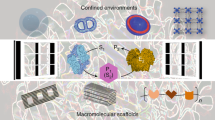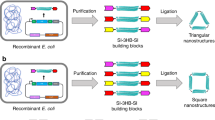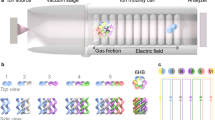Abstract
In nature, the catalytic efficiency of multienzyme complexes highly depends on their spatial organization. The positions and orientations of the composite enzymes are often precisely controlled to facilitate substrate transport between them. Self-assembled DNA nanostructures hold great promise for organizing biomolecules at the nanoscale. Here, we present detailed protocols for exploiting DNA nanostructures as assembly scaffolds that organize the spatial arrangements of multienzyme cascades with control over their relative distance, compartmentalization and substrate diffusion paths. The protocol describes the preparation and purification of DNA-conjugated enzymes and cofactors, along with the assembly of these prepared complexes on DNA nanostructures. The architecture of assembled enzyme complexes is then readily characterized using a broad selection of techniques from routine gel electrophoresis to advanced single-molecule imaging. We also describe methods of purifying these nano-assemblies and testing them with functional assays based on either bulk or single-molecule fluorescence measurements. The entire assembly and characterization of a multienzyme complex can be completed within 1–2 weeks.
This is a preview of subscription content, access via your institution
Access options
Subscribe to this journal
Receive 12 print issues and online access
$259.00 per year
only $21.58 per issue
Buy this article
- Purchase on Springer Link
- Instant access to full article PDF
Prices may be subject to local taxes which are calculated during checkout











Similar content being viewed by others
References
Savage, D.F., Afonso, B., Chen, A.H. & Silver, P.A. Spatially ordered dynamics of the bacterial carbon fixation machinery. Science 327, 1258–1261 (2010).
Srere, P.A. & Mosbach, K. Metabolic compartmentation: symbiotic, organellar, multienzymic, and microenvironmental. Annu. Rev. Microbiol. 28, 61–84 (1974).
Seeman, N.C. Nucleic acid junctions and lattices. J. Theor. Biol. 99, 237–247 (1982).
Fu, T.J. & Seeman, N.C. DNA double-crossover molecules. Biochemistry 32, 3211–3220 (1993).
Seeman, N.C. Nanomaterials based on DNA. Annu. Rev. Biochem. 79, 65–87 (2010).
Rothemund, P.W.K. Folding DNA to create nanoscale shapes and patterns. Nature 440, 297–302 (2006).
Ke, Y., Ong, L.L., Shih, W.M. & Yin, P. Three-dimensional structures self-assembled from DNA bricks. Science 338, 1177–1183 (2012).
Wei, B., Dai, M. & Yin, P. Complex shapes self-assembled from single-stranded DNA tiles. Nature 485, 623–626 (2012).
Zhang, F., Nangreave, J., Liu, Y. & Yan, H. Structural DNA nanotechnology: state of the art and future perspective. J. Am. Chem. Soc. 136, 11198–11211 (2014).
Douglas, S.M. et al. Self-assembly of DNA into nanoscale three-dimensional shapes. Nature 459, 414–418 (2009).
Dietz, H., Douglas, S.M. & Shih, W.M. Folding DNA into twisted and curved nanoscale shapes. Science 325, 725–730 (2009).
Han, D. et al. DNA origami with complex curvatures in three-dimensional space. Science 332, 342–346 (2011).
Benson, E. et al. DNA rendering of polyhedral meshes at the nanoscale. Nature 523, 441–444 (2015).
Zhang, F. et al. Complex wireframe DNA origami nanostructures with multi-arm junction vertices. Nat. Nanotechnol. 10, 779–784 (2015).
Ke, Y. et al. DNA brick crystals with prescribed depths. Nat. Chem. 6, 994–1002 (2014).
Zheng, J. et al. From molecular to macroscopic via the rational design of a self-assembled 3D DNA crystal. Nature 461, 74–77 (2009).
Douglas, S.M. et al. Rapid prototyping of 3D DNA-origami shapes with caDNAno. Nucleic Acids Res. 37, 5001–5006 (2009).
Castro, C.E. et al. A primer to scaffolded DNA origami. Nat. Methods 8, 221–229 (2011).
Williams, S. et al. Tiamat: a three-dimensional editing tool for complex DNA structures. in DNA Computing (eds. Goel, A., Simmel, F.C. & Sosík, P.) 90–101 (Springer-Verlag Berlin Heidelberg, Germany, 2009).
Fu, J., Liu, M., Liu, Y. & Yan, H. Spatially-interactive biomolecular networks organized by nucleic acid nanostructures. Acc. Chem. Res. 45, 1215–1226 (2012).
Pinheiro, A.V., Han, D., Shih, W.M. & Yan, H. Challenges and opportunities for structural DNA nanotechnology. Nat. Nanotechnol. 6, 763–772 (2011).
Zhang, T., Collins, J., Arbuckle-Keil, G.A. & Fu, J. DNA-directed assembly of conductive nanomaterials. Adv. Sci. Eng. Med. 7, 1019–1032 (2015).
Zhang, T., Collins, J. & Fu, J. Single-molecule sensing of biomolecular interactions on DNA nanostructures. Curr. Nanosci. 11, 722–735 (2015).
Yang, Y.R., Liu, Y. & Yan, H. DNA nanostructures as programmable biomolecular scaffolds. Bioconjug. Chem. 26, 1381–1395 (2015).
Fu, J., Liu, M., Liu, Y., Woodbury, N.W. & Yan, H. Interenzyme substrate diffusion for an enzyme cascade organized on spatially addressable DNA nanostructures. J. Am. Chem. Soc. 134, 5516–5519 (2012).
Wilner, O.I. et al. Enzyme cascades activated on topologically programmed DNA scaffolds. Nat. Nanotechnol. 4, 249–254 (2009).
Erkelenz, M., Kuo, C.H. & Niemeyer, C.M. DNA-mediated assembly of cytochrome P450 BM3 subdomains. J. Am. Chem. Soc. 133, 16111–16118 (2011).
Fu, J. et al. Multi-enzyme complexes on DNA scaffolds capable of substrate channelling with an artificial swinging arm. Nat. Nanotechnol. 9, 531–536 (2014).
Liu, M. et al. A DNA tweezer-actuated enzyme nanoreactor. Nat. Commun. 4, 2127 (2013).
Xin, L., Zhou, C., Yang, Z. & Liu, D. Regulation of an enzyme cascade reaction by a DNA machine. Small 9, 3088–3091 (2013).
Andersen, E.S. et al. Self-assembly of a nanoscale DNA box with a controllable lid. Nature 459, 73–76 (2009).
Douglas, S.M., Bachelet, I. & Church, G.M. A logic-gated nanorobot for targeted transport of molecular payloads. Science 335, 831–834 (2012).
Zhao, Z. et al. Nanocaged enzymes with enhanced catalytic activity and increased stability against protease digestion. Nat. Commun. 7, 10619 (2016).
Juul, S. et al. Temperature-controlled encapsulation and release of an active enzyme in the cavity of a self-assembled DNA nanocage. ACS Nano 7, 9724–9734 (2013).
Linko, V., Eerikäinen, M. & Kostiainen, M.A. A modular DNA origami-based enzyme cascade nanoreactor. Chem. Commun. 51, 5351–5354 (2015).
Fu, Y. et al. Single-step rapid assembly of DNA origami nanostructures for addressable nanoscale bioreactors. J. Am. Chem. Soc. 135, 696–702 (2013).
Niemeyer, C.M. Semisynthetic DNA–protein conjugates for biosensing and nanofabrication. Angew. Chem. Int. Ed. Engl. 49, 1200–1216 (2010).
Chhabra, R. et al. Spatially addressable multiprotein nanoarrays templated by aptamer-tagged DNA nanoarchitectures. J. Am. Chem. Soc. 129, 10304–10305 (2007).
Witus, L.S. & Francis, M. Site-specific protein bioconjugation via a pyridoxal 5′-phosphate-mediated N-terminal transamination reaction. Curr. Protoc. Chem. Biol. 2, 125–134 (2010).
Shen, W., Zhong, H., Neff, D. & Norton, M.L. NTA directed protein nanopatterning on DNA origami nanoconstructs. J. Am. Chem. Soc. 131, 6660–6661 (2009).
Duckworth, B.P. et al. A universal method for the preparation of covalent protein–DNA conjugates for use in creating protein nanostructures. Angew. Chem. Weinheim. Bergstr. Ger. 119, 8819–8822 (2007).
Fang, X., Li, J.J. & Tan, W. Using molecular beacons to probe molecular interactions between lactate dehydrogenase and single-stranded DNA. Anal. Chem. 72, 3280–3285 (2000).
Cattaneo, A., Biocca, S., Corvaja, N. & Calissano, P. Nuclear localization of a lactic dehydrogenase with single-stranded DNA-binding properties. Exp. Cell Res. 161, 130–140 (1985).
Kaiserman, H.B., Odenwald, W.F., Stowers, D.J., Poll, E.H. & Benbow, R.M. A major single-stranded DNA binding protein from ovaries of the frog, Xenopus laevis, is lactate dehydrogenase. Biochim Biophys Acta 1008, 23–30 (1989).
Fiume, L. et al. Galloflavin prevents the binding of lactate dehydrogenase A to single stranded DNA and inhibits RNA synthesis in cultured cells. Biochem. Biophys. Res. Commun. 430, 466–469 (2013).
Schmied, J.J. et al. DNA origami–based standards for quantitative fluorescence microscopy. Nat. Protoc. 9, 1367–1391 (2014).
Widom, J.R., Dhakal, S., Heinicke, L.A. & Walter, N.G. Single molecule tools for enzymology, structural biology, systems biology and nanotechnology: an update. Arch. Toxicol. 88, 1965–1985 (2014).
Bellot, G., McClintock, M.A., Lin, C. & Shih, W.M. Recovery of intact DNA nanostructures after agarose gel-based separation. Nat. Methods 8, 192–194 (2011).
Dhakal, S. et al. Rational design of DNA-actuated enzyme nanoreactors guided by single molecule analysis. Nanoscale 8, 3125–3137 (2016).
Liu, M. et al. A three-enzyme pathway with an optimised geometric arrangement to facilitate substrate transfer. ChemBioChem 17, 1097–1101 (2016).
Zhao, Z., Jacovetty, E.L., Liu, Y. & Yan, H. Encapsulation of gold nanoparticles in a DNA origami cage. Angew. Chem. Int. Ed. Engl. 50, 2041–2044 (2011).
Goodman, R.P. et al. Reconfigurable, braced, three-dimensional DNA nanostructures. Nat. Nanotechnol. 3, 93–96 (2008).
Gao, Y. et al. Tuning enzyme kinetics through designed intermolecular interactions far from the active site. ACS Catal. 5, 2149–2153 (2015).
Golub, E., Albada, H.B., Liao, W.-C., Biniuri, Y. & Willner, I. Nucleoapzymes: hemin/G-quadruplex DNAzyme–aptamer binding site conjugates with superior enzyme-like catalytic functions. J. Am. Chem. Soc. 138, 164–172 (2016).
Wheeldon, I. et al. Substrate channelling as an approach to cascade reactions. Nat. Chem. 8, 299–309 (2016).
Dueber, J.E. et al. Synthetic protein scaffolds provide modular control over metabolic flux. Nat. Biotechnol. 27, 753–759 (2009).
You, C., Myung, S. & Zhang, Y.-H.P. Facilitated substrate channeling in a self-assembled trifunctional enzyme complex. Angew. Chem. Int. Ed. Engl. 51, 8787–8790 (2012).
Sheldon, R.A. Cross-linked enzyme aggregates (CLEAs): stable and recyclable biocatalysts. Biochem. Soc. Trans. 35, 1583–1587 (2007).
Sheldon, R.A. Enzyme immobilization: the quest for optimum performance. Adv. Synth. Catal. 349, 1289–1307 (2007).
Cha, T., Guo, A. & Zhu, X.-Y. Enzymatic activity on a chip: the critical role of protein orientation. Proteomics 5, 416–419 (2005).
Clarizia, L.-J.A. et al. Antibody orientation enhanced by selective polymer–protein noncovalent interactions. Anal. Bioanal. Chem. 393, 1531–1538 (2009).
Kim, J., Jia, H. & Wang, P. Challenges in biocatalysis for enzyme-based biofuel cells. Biotechnol. Adv. 24, 296–308 (2006).
Comellas-Aragones, M. et al. A virus-based single-enzyme nanoreactor. Nat. Nanotechnol. 2, 635–639 (2007).
Fiedler, J.D., Brown, S.D., Lau, J.L. & Finn, M.G. RNA-directed packaging of enzymes within virus-like particles. Angew. Chem. Int. Ed. Engl. 49, 9648–9651 (2010).
Yoshimoto, M. Stabilization of enzymes through encapsulation in liposomes. in Enzyme Stabilization and Immobilization: Methods and Protocols (ed. Minteer, S.D.) 9–18 (Humana Press, New York, 2011).
Gaitzsch, J., Huang, X. & Voit, B. Engineering functional polymer capsules toward smart nanoreactors. Chem. Rev. 116, 1053–1093 (2016).
Liu, Y. et al. Biomimetic enzyme nanocomplexes and their use as antidotes and preventive measures for alcohol intoxication. Nat. Nanotechnol. 8, 187–192 (2013).
Betancor, L. & Luckarift, H.R. Bioinspired enzyme encapsulation for biocatalysis. Trends Biotechnol. 26, 566–572 (2008).
Ding, Y., Chuan, Y.P., He, L. & Middelberg, A.P.J. Modeling the competition between aggregation and self-assembly during virus-like particle processing. Biotechnol. Bioeng. 107, 550–560 (2010).
Vriezema, D.M. et al. Self-assembled nanoreactors. Chem. Rev. 105, 1445–1490 (2005).
Guo, P. The emerging field of RNA nanotechnology. Nat. Nanotechnol. 5, 833–842 (2010).
Delebecque, C.J., Lindner, A.B., Silver, P.A. & Aldaye, F.A. Organization of intracellular reactions with rationally designed RNA assemblies. Science 333, 470–474 (2011).
ElSohly, A.M. & Francis, M.B. Development of oxidative coupling strategies for site-selective protein modification. Acc. Chem. Res. 48, 1971–1978 (2015).
Rosen, C.B. et al. Template-directed covalent conjugation of DNA to native antibodies, transferrin and other metal-binding proteins. Nat. Chem. 6, 804–809 (2014).
Hahn, J., Wickham, S.F.J., Shih, W.M. & Perrault, S.D. Addressing the instability of DNA nanostructures in tissue culture. ACS Nano 8, 8765–8775 (2014).
Summers, F.A., Zhao, B., Ganini, D. & Mason, R.P. Photooxidation of amplex red to resorufin: implications of exposing the amplex red assay to light. Methods Enzymol. 526, 1–17 (2013).
Schmidt, T.L. et al. Scalable amplification of strand subsets from chip-synthesized oligonucleotide libraries. Nat. Commun. 6, 8634 (2015).
Lin, C., Xie, M., Chen, J.J.L., Liu, Y. & Yan, H. Rolling-circle amplification of a DNA nanojunction. Angew. Chem. Int. Ed. Engl. 45, 7537–7539 (2006).
Marchi, A.N., Saaem, I., Tian, J. & LaBean, T.H. One-pot assembly of a hetero-dimeric DNA origami from chip-derived staples and double-stranded scaffold. ACS Nano 7, 903–910 (2013).
Ducani, C., Kaul, C., Moche, M., Shih, W.M. & Högberg, B. Enzymatic production of ′monoclonal stoichiometric′ single-stranded DNA oligonucleotides. Nat. Methods 10, 647–652 (2013).
Blanco, M. & Walter, N.G. Analysis of complex single-molecule FRET time trajectories. Methods Enzymol. 472, 153–178 (2010).
Gourévitch, B. & Eggermont, J.J. A nonparametric approach for detection of bursts in spike trains. J. Neurosci. Methods 160, 349–358 (2007).
Rinaldi, A.J., Lund, P.E., Blanco, M.R. & Walter, N.G. The Shine-Dalgarno sequence of riboswitch-regulated single mRNAs shows ligand-dependent accessibility bursts. Nat. Commun. 7, 8976 (2016).
Michelotti, N., de Silva, C., Johnson-Buck, A.E., Manzo, A.J. & Walter, N.G. A bird's eye view: tracking slow nanometer-scale movements of single molecular nano-assemblies. Methods Enzymol. 475, 121–148 (2010).
Johnson-Buck, A. & Walter, N.G. Discovering anomalous hybridization kinetics on DNA nanostructures using single-molecule fluorescence microscopy. Methods 67, 177–184 (2014).
Rowland, P., Basak, A.K., Gover, S., Levy, H.R. & Adams, M.J. The three–dimensional structure of glucose 6–phosphate dehydrogenase from Leuconostoc mesenteroides refined at 2.0 Å resolution. Structure 2, 1073–1087 (1994).
Chapman, A.D.M., Cortés, A., Dafforn, T.R., Clarke, A.R. & Brady, R.L. Structural basis of substrate specificity in malate dehydrogenases: crystal structure of a ternary complex of porcine cytoplasmic malate dehydrogenase, α-Ketomalonate and TetrahydoNAD. J. Mol. Biol. 285, 703–712 (1999).
Acknowledgements
This work was supported by an Army Research Office YIP award (W911NF-14-1-0434) and the Cottrell College Science Award to J.F., and an Army Research Office MURI award (W911NF-12-1-0420) to H.Y. and N.G.W. J.F. is supported by startup funds from Rutgers University. H.Y. is also supported by the NIH Transformative award R01GM104960 and the Presidential Strategic Initiative Fund from Arizona State University. We thank K. Taylor for proofreading the manuscript.
Author information
Authors and Affiliations
Contributions
J.F., Y.R.Y., M.L. and T.Z. developed the DNA–enzyme conjugation and purification procedure; J.F., Y.R.Y. and M.L. developed the process for enzyme assembly on 2D DNA nanostructures, and characterized the activity; J.F. and Z.Z. designed DNA nanocages for enzyme encapsulation and performed activity assay in bulk solution; S.D. developed single-molecule fluorescence experiments and analyzed data; and J.F., N.G.W. and H.Y. conceived the concepts and supervised the projects. All authors contributed to the writing of the manuscript.
Corresponding author
Ethics declarations
Competing interests
The authors declare no competing financial interests.
Integrated supplementary information
Supplementary Figure 1 Assembly of a DNA origami tile.
A M13 mp 18 ssDNA scaffold is incubated with a set of hundreds of staples strands, which are thermally annealed for assembling DNA origami nanostructures.
Supplementary Figure 2 Designed DNA nanostructures for enzyme assembly.
(a) A DNA DX tile. (b) A four-way junction tile. (c) A rectangular DNA origami tile. (d) A 3D DNA nanocage based on honeycomb folding pattern.
Supplementary information
Supplementary Text and Figures
Supplementary Figures 1–3 and Supplementary Methods (PDF 373 kb)
Supplementary Data
DNA structures. (ZIP 550 kb)
Supplementary Software
Custom-written IDL (Interactive Data Language) and MATLAB scripts. (ZIP 78 kb)
Rights and permissions
About this article
Cite this article
Fu, J., Yang, Y., Dhakal, S. et al. Assembly of multienzyme complexes on DNA nanostructures. Nat Protoc 11, 2243–2273 (2016). https://doi.org/10.1038/nprot.2016.139
Published:
Issue Date:
DOI: https://doi.org/10.1038/nprot.2016.139
This article is cited by
-
Skeletal remains of human perinatal individuals from the fortified Iberian Period settlement of Ca n’Oliver (6th century to 50 years BCE)
Archaeological and Anthropological Sciences (2023)
-
Nucleic acid-based scaffold systems and application in enzyme cascade catalysis
Applied Microbiology and Biotechnology (2023)
-
Redesigning Robust Biocatalysts by Engineering Enzyme Microenvironment and Enzyme Immobilization
Catalysis Letters (2023)
-
Functionalizing DNA origami to investigate and interact with biological systems
Nature Reviews Materials (2022)
-
DNA origami
Nature Reviews Methods Primers (2021)
Comments
By submitting a comment you agree to abide by our Terms and Community Guidelines. If you find something abusive or that does not comply with our terms or guidelines please flag it as inappropriate.



